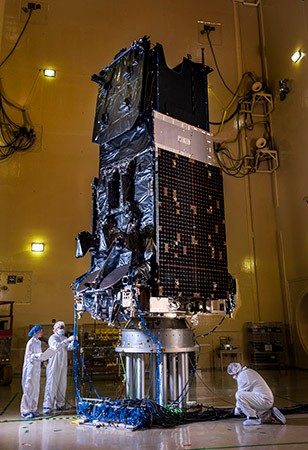The U.S. Space Force’s latest missile warning satellite is ready for launch, after finishing production nearly a month ahead of schedule.
Lockheed Martin’s sixth Space Based Infrared System Geosynchronous Earth Orbit (SBIRS GEO-6) missile warning satellite is now in storage awaiting its expected launch in 2022. SBIRS GEO-6 is the second military space satellite built on Lockheed Martin’s modernized LM2100 Combat Bus™ -- an enhanced space vehicle that provides even greater resiliency and cyber-hardening against growing threats, as well as improved spacecraft power, propulsion and electronics.
On Sept. 2, 2021, the U.S. Space Force’s Space Systems Command determined that the SBIRS GEO-6 was complete. The satellite went into storage nearly a month ahead of its Sept. 30 Acquisition Program Baseline (APB) requirement date.
Once launched, SBIRS GEO-6 will join the Space Force’s constellation of missile warning satellites, equipped with powerful scanning and staring infrared surveillance sensors that protect our nation 24-7. These sensors collect data that allow the U.S. military to detect missile launches, support ballistic missile defense, expand technical intelligence gathering and bolster situational awareness on the battlefield.

New Bus Design Means Greater Resiliency and Enhanced Capabilities
Like its immediate predecessor, SBIRS GEO-5, which launched on May 18, 2021, SBIRS GEO-6 is built on a modernized space vehicle design. The enhanced LM2100 Combat Bus provides:
- Greater resiliency and cyber-hardening
- Enhanced spacecraft power, propulsion and electronics
- Common components and procedures to streamline manufacturing
- Flexible design that reduces the cost to incorporate future, modernized sensor suites
The SBIRS GEO-5 space vehicle continues to prove itself. In June 2021, SBIRS GEO-5 turned on its powerful sensors for the first time during space vehicle checkout and transmitted its first images back to Earth in a milestone known as "First Light."
“Furthermore, the performance of SBIRS GEO-5’s LM2100 Combat Bus has exceeded expectations throughout the on orbit test campaign since its launch,” said Tom McCormick, Lockheed Martin’s vice president for Overhead Persistent Infrared Systems.
Upgrade Provides Flexibility for Evolving Threats and Mission Needs
SBIRS GEO-6 and GEO-5 were originally slated to be clones of previous SBIRS satellites produced by Lockheed Martin. Then in 2015, the U.S. Air Force agreed to rebaseline the contract for the two satellites and upgrade both–at no additional cost–to the LM 2100 Combat Bus, taking advantage of a Lockheed Martin internally funded, multiyear modernization initiative.
“We are proud to deliver additional overhead persistent infrared capabilities critical to our Nation’s defense with SBIRS GEO-5 and GEO-6. The LM2100 Combat Bus continues to be an effective platform to help meet the Chief of Space Operations’ vision for streamlined space acquisitions,” said Col. Matt Spencer, Senior Materiel Leader for Space Systems Command’s GEO/Polar Division.
“The LM2100 is a game changer for military satellite design providing satellite production efficiency, enhanced resiliency options and so much more flexibility for additional payloads and sensors,” said McCormick. “From the LM2100, we’ve really been able to enhance resiliency developing a ‘Combat Bus’ and a bridge to achieving the resilient missile warning required for the Space Force’s Next-Gen OPIR Block 0 System.”




